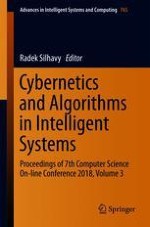This book presents new approaches and methods applied to real-world problems, and in particular, exploratory research relating to novel approaches in the field of cybernetics and automation control theory. Particularly focusing on modern trends in selected fields of interest, it presents new algorithms and methods in intelligent systems in cybernetics. This book constitutes the third volume of the refereed proceedings of the Cybernetics and Algorithms in Intelligent Systems Section of the 7th Computer Science On-line Conference 2018 (CSOC 2018), held online in April 2018.
